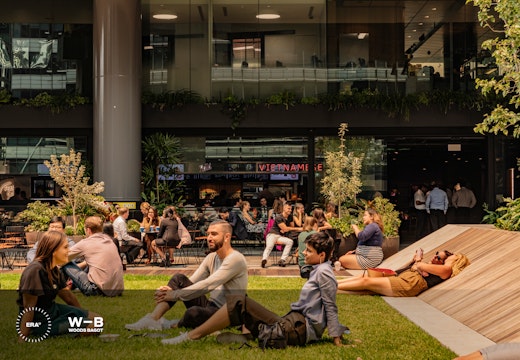The new state of wellness: a renewed focus on building green
How can we enable a work-from-anywhere workforce? Great public spaces and transport links are a good place to start
Since the pandemic there has been a lot of focus on how spaces can be reimagined to facilitate new works of living and working. Wellbeing and sustainable living have also become prominent talking points within governments, institutions and the workplace.
Now, as we look beyond the pandemic urban designers and planners are thinking about how they can take the learnings from the pandemic and apply them to our urban environments. One popular theory is to improve local transport routes and increase the number of public green spaces available to citizens.
In October 2020, Woods Bagot commissioned ERA-co to interrogate the possibility of increasing and diversifying usage of green space, and to model the impact on people and households across broader Sydney. In a report entitled ‘Streets Ahead: An Interactive Place Study’ ERA-Co explored the idea of closing quiet community streets to cars to create vibrant places for local communities to come together.
‘When distributed working becomes the new norm, our streets can make a positive impact on wellbeing…’
This approach found that it could take up to 100,000 cars off the road – equal to almost 30 per cent of residents’ cars from the study area – resulting in almost $1.3 billion in yearly household savings. A key finding is that if rolled out across a wider area, closing quiet streets in this way would satisfy the New South Wales Premier’s priority to increase the proportion of homes in urban areas that are within 10 minutes’ walk of quality green, open and public space by 10 per cent by 2023.
The impact on wellbeing
In support of the hope for a greener, cooler future, de-paving quiet streets within 800 metres of major public transport stops would put 530,000 local people within 300 metres of this new public green space. This is 260,000 more people than currently. At least another 80,000 trees could be planted, further reducing the heat island effect. Compellingly, the scenario represents an increase in life satisfaction that could equate to $2.9 billion annually.
In research done in the UK, access to at least one hectare of green space within 300 metres has been linked to a 0.8 increase in life satisfaction. Making these changes will convert Sydney’s transport hubs into local neighbourhood havens and ensure that the ‘first and last mile’ of travel is enjoyable.
When distributed working becomes the new norm, our streets can make a positive impact on wellbeing by bringing nature and even street-sourced produce to our front doors. If we act now, New South Wales will be a state transformed – greener, happier and more community-minded.








